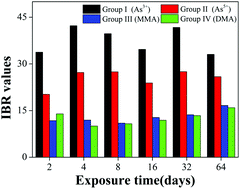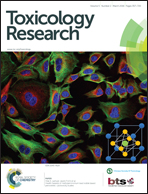Accumulation, biotransformation, and multi-biomarker responses after exposure to arsenic species in the earthworm Eisenia fetida†
Abstract
Earthworms (Eisenia fetida) were exposed to OECD soils contaminated with arsenite (29.3 mg kg−1), arsenate (35.2 mg kg−1), monomethylarsonate (342.5 mg kg−1) and dimethylarsinate (373.0 mg kg−1) for 64 days. The exposure concentration for the four arsenic species was set at one-tenth of 14 d-LC50 in order to compare their toxicity. Eight biomarkers including superoxide dismutase, catalase, glutathione peroxidase, glutathione S-transferase, glutathione reductase, reduced glutathione, lipid peroxidation and metallothioneins were analyzed in the organisms. A multi-biomarker approach, the integrated biomarker response (IBR) index, was adopted to summarize the multi-biomarker responses to a single value, reflecting the integrated stress of different arsenic species on earthworms. Furthermore, total arsenic and arsenic speciation were analyzed in earthworm tissue to evaluate the relationship between arsenic accumulation and biomarker responses at the molecular and subcellular levels and to observe the role of arsenic biotransformation in earthworms. The results showed that the toxicity of the four arsenic species was ranked as: arsenite > arsenate > monomethylarsonate and dimethylarsinate. Although organic arsenics showed a low degree of biotoxicity, they could be turned into highly toxic inorganic arsenics under the effect of demethylation, which caused a toxic effect on organisms. The biomarker responses indicated that a sub-lethal dose of both arsenite and arsenate could trigger the response of the antioxidant defense system and cause oxidative damage when the protective capacity of the system was exhausted. Arsenic in earthworms could be detoxified during the process of biotransformation, where inorganic arsenics were converted into organic arsenics, which would then be excreted out. Based on these results, it was proved that different arsenic species showed different degrees of toxicity. Therefore, arsenic species should be differentiated in order to obtain accurate results in quality/risk assessment programs.


 Please wait while we load your content...
Please wait while we load your content...